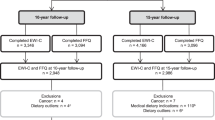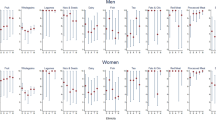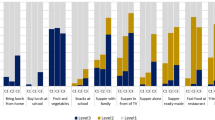Abstract
Background/Objectives:
Despite increased risk for unhealthy diets, some socioeconomically disadvantaged adolescents manage to consume a healthy diet, thereby showing ‘dietary resilience’. This investigation aimed to describe the vegetable and fruit intakes of socioeconomically disadvantaged adolescents, and explore the intrapersonal, social and environmental factors associated with more favourable dietary intakes among socioeconomically disadvantaged adolescents.
Subjects/Methods:
The present investigation draws on data from 1014 socioeconomically disadvantaged adolescents (55% girls), a sub-sample of 3264 adolescents aged 12–15 years recruited from 37 secondary schools in Victoria, Australia. The adolescents completed an online survey in 2004–2005 comprising an FFQ and questions pertaining to intrapersonal, social and environmental factors informed by the Social Cognitive Theory (SCT). Frequent vegetable and fruit intake was defined as ⩾2 times per day and ⩾1 time per day, respectively.
Results:
Approximately one-third of socioeconomically disadvantaged adolescents frequently consumed vegetables and fruit (boys, 29% and 27% respectively; girls, 29% and 36% respectively). Greater perceived importance of health, and frequently being served vegetables with dinner, were associated with frequent intakes. Friends’ support for healthy eating was associated with boys’ frequent vegetable intake. Less stringent adherence to family meal-time rules was associated with frequent intakes; however, the opposite was observed when girls were expected to eat all foods served.
Conclusions:
Nutrition promotion messages targeting socioeconomically disadvantaged adolescents could focus on fostering appreciation for health and providing families with strategies to increase meal-time vegetable availability. Friends could be encouraged to support healthy eating among boys. Family meal-time rules warrant further investigation.
This is a preview of subscription content, access via your institution
Access options
Subscribe to this journal
Receive 12 print issues and online access
$259.00 per year
only $21.58 per issue
Buy this article
- Purchase on Springer Link
- Instant access to full article PDF
Prices may be subject to local taxes which are calculated during checkout
Similar content being viewed by others
References
Ball K, Crawford D (2006). Socio-economic factors in obesity: a case of slim chance in a fat world? Asia Pac J Clin Nutr 15, 15–20.
Ball K, MacFarlane A, Crawford D, Savige G, Andrianopoulos N, Worsley A (2009). Can social cognitive theory constructs explain socio-economic variations in adolescent eating behaviours? A mediation analysis. Health Educ Res 24, 496–506.
Bandura A (1986). Social Foundations of Thoughts and Action: a Social Cognitive Theory. Prentice-Hall: Englewood Cliffs, NJ.
Bere E, van Lenthe F, Klepp K-I, Brug J (2008). Why do parents’ education level and income affect the amount of fruits and vegetables adolescents eat? Eur J Public Health 18, 611–615.
Campbell KJ, Crawford DA, Salmon J, Carver A, Garnett SP, Baur LA (2007). Associations between the home food environment and obesity-promoting eating behaviors in adolescence. Obesity (Silver Spring) 15, 719–730.
Contento IR, Williams SS, Michela JL, Franklin AB (2006). Understanding the food choice process of adolescents in the context of family and friends. J Adolesc Health 38, 575–582.
De Bourdeaudhuij I (1997). Family food rules and healthy eating in adolescents. J Health Psych 2, 45–56.
Department of Health and Ageing (2001). The Australian Guide to Healthy Eating. Australian Government: Canberra, ACT.
Department of Health and Ageing, Australian Food and Grocery Council & Department of Agriculture Fisheries and Forestry (2008). 2007 Australian National Children's Nutrition and Physical Activity Survey—Main Findings. Australian Government: Canberra, ACT.
Di Noia J, Schinke SP, Prochaska JO, Contento IR (2006). Application of the transtheoretical model to fruit and vegetable consumption among economically disadvantaged African-American adolescents: preliminary findings. Am J Health Promot 20, 342–348.
Evans AE, Wilson DK, Buck J, Torbett H, Williams J (2006). Outcome expectations, barriers, and strategies for healthful eating: a perspective from adolescents from low-income families. Fam Community Health 29, 17–27.
Fulkerson JA, Neumark-Sztainer D, Story M (2006). Adolescent and parent views of family meals. J Am Diet Assoc 106, 526–532.
Haerens L, Craeynest M, Deforche B, Maes L, Cardon G, De Bourdeaudhuij I (2008). The contribution of psychosocial and home environmental factors in explaining eating behaviours in adolescents. Eur J Clin Nutr 62, 51–59.
Hupkens CL, Knibbe RA, Van Otterloo AH, Drop MJ (1998). Class differences in the food rules mothers impose on their children: a cross-national study. Soc Sci Med 47, 1331–1339.
Kremers SP, Brug J, de Vries H, Engels RC (2003). Parenting style and adolescent fruit consumption. Appetite 41, 43–50.
Larson NI, Neumark-Sztainer D, Hannan PJ, Story M (2007). Trends in adolescent fruit and vegetable consumption, 1999–2004, Project EAT. Am J Prev Med 32, 147–150.
MacFarlane A, Crawford D, Ball K, Savige G, Worsley A (2007). Adolescent home food environments and socioeconomic position. Asia Pac J Clin Nutr 16, 748–756.
Marks GC, Webb K, Rutishauser IHE, Riley M, Commonwealth Department of Health Aged Care (2001). Monitoring Food Habits in the Australian Population using Short Questions. Australian Government: Canberra, ACT.
Masten AS, Wright MOD (2009). Resilience over the lifespan: developmental perspectives on resistance, recovery, and transformation. In: Reich JW, Zautra AJ, Hall JS (eds). Handbook of Adult Resilience. Guildford Press: New York, NY, pp 213–237.
McCullough ML, Robertson AS, Chao A, Jacobs EJ, Stampfer MJ, Jacobs DR et al. (2003). A prospective study of whole grains, fruits, vegetables and colon cancer risk. Cancer Causes Control 14, 959–970.
Nelson M, Erens B, Bates B, Church S, Boshier T (2007). Low Income Diet and Nutrition Survey—Volume 2: Food Consumption, Nutrient Intake. TSO: London.
Neumark-Sztainer D, Wall M, Perry C, Story M (2003). Correlates of fruit and vegetable intake among adolescents. Findings from Project EAT. Prev Med 37, 198–208.
O’Dea JA (2003). Why do kids eat healthful food? Perceived benefits of and barriers to healthful eating and physical activity among children and adolescents. J Am Diet Assoc 103, 497–501.
O’Rourke N, Hatcher L, Stepanski E (2005). A Step-by-Step Approach to using SAS for Univariate and Multivariate Statistics, 2nd edn. SAS Institute Inc.: Cary, NC.
Pearson N, Biddle SJ, Gorely T (2009). Family correlates of fruit and vegetable consumption in children and adolescents: a systematic review. Public Health Nutr 12, 267–283.
Rasmussen M, Krolner R, Klepp KI, Lytle L, Brug J, Bere E et al. (2006). Determinants of fruit and vegetable consumption among children and adolescents: a review of the literature. Part I: quantitative studies. Int J Behav Nutr Phys Act 3, 22.
Sallis JF, Grossman RM, Pinksi RB, Patterson TL, Nader PR (1987). The development of scales to measure social support for diet and exercise behaviours. Prev Med 16, 825–863.
Savige G, Macfarlane A, Ball K, Worsley A, Crawford D (2007a). Snacking behaviours of adolescents and their association with skipping meals. Int J Behav Nutr Phys Act 4, 36.
Savige GS, Ball K, Worsley A, Crawford D (2007b). Food intake patterns among Australian adolescents. Asia Pac J Clin Nutr 16, 738–747.
Shi Z, Lien N, Kumar BN, Holmboe-Ottesen G (2005). Socio-demographic differences in food habits and preferences of school adolescents in Jiangsu Province, China. Eur J Clin Nutr 59, 1439–1448.
Spear BA (2002). Adolescent growth and development. J Am Diet Assoc 102, S23–S29.
Stanton CA, Green SL, Fries EA (2007). Diet-specific social support among rural adolescents. J Nutr Educ Behav 39, 214–218.
Steinmetz KA, Potter JD (1996). Vegetables, fruit, and cancer prevention: a review. J Am Diet Assoc 96, 1027–1039.
te Velde SJ, Twisk JW, Brug J (2007). Tracking of fruit and vegetable consumption from adolescence into adulthood and its longitudinal association with overweight. Br J Nutr 98, 431–438.
Turrell G, Hewitt B, Patterson C, Oldenburg B, Gould T (2002). Socioeconomic differences in food purchasing behaviour and suggested implications for diet-related health promotion. J Hum Nutr Diet 15, 355–364.
van der Horst K, Oenema A, Ferreira I, Wendel-Vos W, Giskes K, van Lenthe F et al. (2007). A systematic review of environmental correlates of obesity-related dietary behaviors in youth. Health Educ Res 22, 203–226.
Vereecken CA, Covents M, Matthys C, Maes L (2005). Young Adolescents’ Nutrition Assessment on Computer (YANA-C). Eur J Clin Nutr 59, 658–667.
Von Post-Skagegard M, Samuelson G, Karlstrom B, Mohsen R, Berglund L, Bratteby LE (2002). Changes in food habits in healthy Swedish adolescents during the transition from adolescence to adulthood. Eur J Clin Nutr 56, 532–538.
Wardle J, Jarvis MJ, Steggles N, Sutton S, Williamson S, Farrimond H et al. (2003). Socioeconomic disparities in cancer-risk behaviors in adolescence: baseline results from the Health and Behaviour In Teenagers Study (HABITS). Prev Med 36, 721–730.
Wardle J, Steptoe A (2003). Socioeconomic differences in attitudes and beliefs about healthy lifestyles. J Epidemiol Community Health 57, 440–443.
World Health Organization (2003). Diet, Nutrition and the Prevention of Chronic Diseases. World Health Organization: Geneva.
Acknowledgements
The study was funded by the Australian Research Council (ID: DP0452044) and the William Buckland Foundation. We thank Dr Nick Andrianopoulos for advice regarding statistical analyses. Sarah McNaughton is supported by a National Health and Medical Research Council (NHMRC) Public Health Postdoctoral Research Fellowship (ID: 323519). David Crawford is supported by a Victorian Health Promotion Foundation Senior Research Fellowship and Kylie Ball is supported by an NHMRC Senior Research Fellowship (ID: 479513). Abbie MacFarlane is supported by an NHMRC Population Health Capacity Building Grant (ID: 425845).
Author information
Authors and Affiliations
Corresponding author
Ethics declarations
Competing interests
The authors declare no conflict of interest.
Rights and permissions
About this article
Cite this article
Stephens, L., McNaughton, S., Crawford, D. et al. Correlates of dietary resilience among socioeconomically disadvantaged adolescents. Eur J Clin Nutr 65, 1219–1232 (2011). https://doi.org/10.1038/ejcn.2011.107
Received:
Revised:
Accepted:
Published:
Issue Date:
DOI: https://doi.org/10.1038/ejcn.2011.107
Keywords
This article is cited by
-
Nutrition promotion approaches preferred by Australian adolescents attending schools in disadvantaged neighbourhoods: a qualitative study
BMC Pediatrics (2015)
-
Describing socioeconomic gradients in children’s diets – does the socioeconomic indicator used matter?
International Journal of Behavioral Nutrition and Physical Activity (2014)



